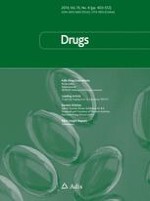Erschienen in:

01.11.2004 | Adis Drug Evaluation
Insulin Detemir
A Review of its Use in the Management of Type 1 and 2 Diabetes Mellitus
verfasst von:
Therese M. Chapman, Caroline M. Perry
Erschienen in:
Drugs
|
Ausgabe 22/2004
Einloggen, um Zugang zu erhalten
Summary
Abstract
Insulin detemir (Levemir®) is a soluble long-acting human insulin analogue acylated with a 14-carbon fatty acid. The fatty acid modification allows insulin detemir to reversibly bind to albumin, thereby providing slow absorption and a prolonged and consistent metabolic effect of up to 24 hours in patients with type 1 or type 2 diabetes mellitus. Insulin detemir has a more predictable, protracted and consistent effect on blood glucose than neutral protamine Hagedorn (NPH) insulin, with less intrapatient variability in glycaemic control, compared with NPH insulin or insulin glargine.
Insulin detemir, administered once or twice daily, is at least as effective as NPH insulin in maintaining overall glycaemic control, with a similar or lower risk of hypoglycaemia, especially nocturnal hypoglycaemia, compared with NPH insulin in patients with type 1 or type 2 diabetes. Insulin detemir also provides the added clinical benefit of no appreciable bodyweight gain in patients with type 1 diabetes and less bodyweight gain than NPH insulin in patients with type 2 diabetes. Insulin detemir is, therefore, a promising new option for basal insulin therapy in patients with type 1 or 2 diabetes.
Pharmacological Properties
Insulin detemir is a soluble long-acting insulin analogue that is acylated with a 14-carbon fatty acid chain. This modification allows for the reversible binding of insulin detemir to albumin, which results in slow absorption and prolonged action over up to 24 hours in patients with diabetes. Insulin detemir is 98–99% albumin bound in plasma.
In vitro receptor binding studies have shown that the affinity of insulin detemir for the insulin receptor and the insulin-like growth factor-1 receptor, and its metabolic and mitogenic potency, are lower than those of both human insulin and insulin glargine.
Insulin detemir has a more predictable glucose-lowering effect than NPH insulin or insulin glargine in patients with type 1 diabetes. The onset to maximum glucose-lowering activity of insulin detemir has been shown to be significantly slower than that of NPH insulin, without a pronounced peak effect, in healthy volunteers.
There was less intrapatient variability in glycaemic control among patients with type 1 diabetes treated with insulin detemir compared with either NPH insulin or insulin glargine.
Insulin detemir is soluble at neutral pH; thus, after administration, the subcutaneous depot remains liquid. As a result, absorption occurs with reduced variability compared with the crystalline/precipitate depots formed by NPH insulin or insulin glargine.
Insulin detemir has an approximately linear and dose-proportional pharmacokinetic profile in healthy adult volunteers and patients with type 2 diabetes. In addition, insulin detemir has a more predictable pharmacokinetic profile than NPH insulin.
The pharmacokinetics of insulin detemir were similar in children, adolescents and adults with type 1 diabetes. Moreover, renal or hepatic impairment did not appear to affect the pharmacokinetics of the drug to a clinically significant extent. Insulin detemir has not shown any clinically significant interactions with other drugs that also bind to albumin.
Clinical Efficacy
Several large (n > 250) randomised, nonblind, multicentre trials of up to 26 weeks’ duration in patients with type 1 or 2 diabetes have assessed the efficacy of subcutaneously administered insulin detemir compared with NPH insulin (each administered once or twice daily) as part of a basal-bolus regimen. Dosages were titrated to achieve target fasting and night-time blood glucose levels. Insulin aspart or regular human insulin were administered as the meal-time insulin. Several trials have been reported as abstracts or posters. Results of trials have shown that insulin detemir provides glycaemic control that is similar to or better than that provided by NPH insulin in patients with type 1 diabetes. Recipients of insulin detemir had fasting plasma glucose levels that were similar to or lower than those achieved with NPH insulin. Glycosylated haemoglobin levels were similar in patients receiving insulin detemir or NPH insulin in most trials and significantly lower with insulin detemir than with NPH insulin in a fully published large trial. Insulin detemir has also been shown to provide good glycaemic control for up to 12 months in long-term extension trials. In addition, insulin detemir achieved glycaemic control similar to that of NPH insulin in patients with type 2 diabetes.
Treatment with insulin detemir resulted in reduced variability in glycaemic values compared with NPH insulin. Moreover, nocturnal glucose profiles were more constant after administration of insulin detemir than after NPH insulin.
In contrast to NPH insulin, treatment with insulin detemir was not usually associated with increases in bodyweight in patients with type 1 diabetes and was associated with significantly less bodyweight gain than NPH insulin in patients with type 2 diabetes.
Tolerability
Insulin detemir is generally well tolerated in patients with type 1 or 2 diabetes. Episodes of major hypoglycaemia have been reported in <10% of patients with type 1 diabetes treated with insulin detemir in randomised clinical trials. The risk of hypoglycaemia in patients receiving insulin detemir was similar to or lower than that of NPH insulin in patients with type 1 diabetes. Insulin detemir also significantly reduced the risk of nocturnal hypoglycaemia compared with NPHinsulin in most randomised clinical trials.
The risk of overall hypoglycaemia or nocturnal hypoglycaemia was similar in patients with type 2 diabetes receiving either insulin detemir (plus insulin aspart) or NPH insulin (plus insulin aspart or regular human insulin).
The most commonly reported adverse events, other than hypoglycaemia, were headache, upper respiratory tract infection and rhinitis. The majority of reported adverse events were mild and not considered to be related to the study drugs.
Minor local reactions around the injection site have occasionally been reported in recipients of insulin detemir.